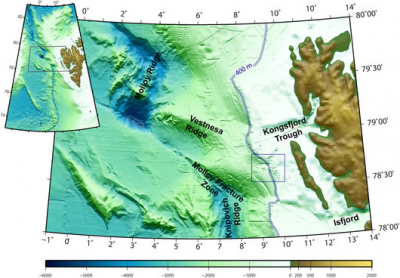Page path:
- Home
- Research
- Expeditions
- 2012
- HE-387
RV HEINCKE HE-387
Gas emissions at the Svalbard continental margin
21.08. - 16.09.2012 (Longyearbyen - Bremerhaven)
Gas hydrates have long been discussed as dynamic methane reservoirs in marine sediments highly susceptible to climate changes in the geological past. In a recent publication, evidences for gas hydrate dissociation are presented (Westbrook et al, 2009, GRL 36), as vigorous gas bubble emissions at the upper continental slope west of Svalbard at water depths around 360 and 400 m were reported. The authors attribute the release of methane to hydrate dissociation due to an observed 1° C temperature increase of the bottom water during the last 30 years. The released methane enters the hydrosphere and eventually the atmosphere, where it could contribute as greenhouse gas to accelerate global warming. The finding has stimulated intensive discussion within the scientific community and as RV Heincke is equipped with novel hydroacoustic equipment, it can contribute to the ongoing research efforts at the west Svalbard continental margin. The EM 710 swath echosounder can be used for systematic mapping of gas emissions using the water column data and for high-resolution mapping of the bathymetry and backscatter characteristics using the seafloor reflections. The intention is to quantify the amount of emitted gas in selected areas by using the fish finding sonar EK 60 as well as the remotely operated vehicle (ROV) Cherokee. Individual emission sites will be sampled for the first time using the ROV and their gas composition will be analysed.
Gas hydrates have long been discussed as dynamic methane reservoirs in marine sediments highly susceptible to climate changes in the geological past. In a recent publication, evidences for gas hydrate dissociation are presented (Westbrook et al, 2009, GRL 36), as vigorous gas bubble emissions at the upper continental slope west of Svalbard at water depths around 360 and 400 m were reported. The authors attribute the release of methane to hydrate dissociation due to an observed 1° C temperature increase of the bottom water during the last 30 years. The released methane enters the hydrosphere and eventually the atmosphere, where it could contribute as greenhouse gas to accelerate global warming. The finding has stimulated intensive discussion within the scientific community and as RV Heincke is equipped with novel hydroacoustic equipment, it can contribute to the ongoing research efforts at the west Svalbard continental margin. The EM 710 swath echosounder can be used for systematic mapping of gas emissions using the water column data and for high-resolution mapping of the bathymetry and backscatter characteristics using the seafloor reflections. The intention is to quantify the amount of emitted gas in selected areas by using the fish finding sonar EK 60 as well as the remotely operated vehicle (ROV) Cherokee. Individual emission sites will be sampled for the first time using the ROV and their gas composition will be analysed.
Contact:

Fig. 1: Major structural elements in the area west of Svalbard. The present-day upper limit of the gas hydrate stability zone is around 400 m water depth (as indicated). The box indicate the area where Westbrook et al. (2009) found gas emissions.


